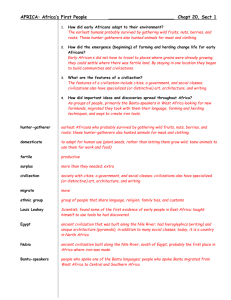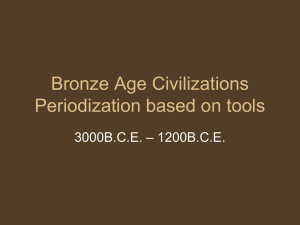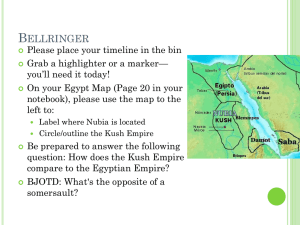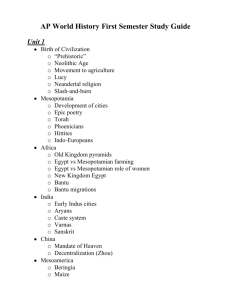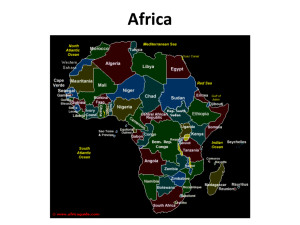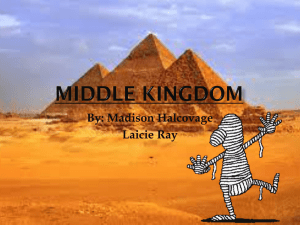Africa Maps
advertisement
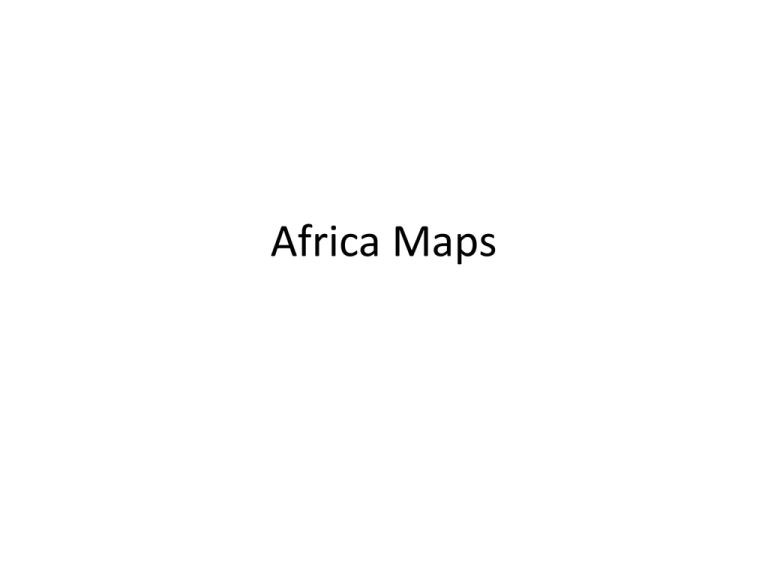
Africa Maps • The area now covered by the Sahara desert is cooler and wetter than it is now, although at this date it is getting dryer. Farming peoples are slowly spreading along the north African coast, and down the fertile strip of land along the river Nile is already home to a dense population of farmers. In this area, some powerful chiefdoms are now emerging which will, over the next few centuries, come under one ruler to form the kingdom of Egypt. Further south, in Nubia, in modernday Sudan, wide grasslands give rise to cattle-herding cultures. Throughout the rest of sub-Saharan Africa, small groups of hunter-gatherers, mostly related to modern day San bushmen and Pygmy peoples, live in small, temporary encampments as they follow their prey and forage for nuts, berries and other nutritious plants. Beside rivers and lakes, settlements of fishermen are situated. Africa 3500-2500 BCE • Northern Africa has continued to get dryer, and the Sahara desert has reached roughly its present size. Farming communities now fringe its northern flank, and in the valley of the Nile, the great civilization of Ancient Egypt has emerged. To its south farming has also spread to Nubia, reaching the southern limits for agriculture based on wheat and barley. In Sub-Saharan Africa, the cattle-herding populations are now ranged over a vast swathe of territory, stretching from modernday Sudan into West Africa. On the rest of the continent live hunter-gatherer peoples and fishermen, mostly related to today’s Pygmies or San Bushmen. Africa 2500-1500 BCE • To the south, in a vast area stretching from the present-day Sudaninto West Africa and down into East Africa, semi-nomadic populations of cattle herders occupy the land. Probably by this date, however, a crucial breakthrough has been made. Somewhere within this huge territory the domestication of sorghum and millet has occurred. These cereals, much more difficult to domesticate than the wheat and barley which originated in western Asia, are suitable for tropical farming and will become the staple crops in the region. For now, however, populations ofhunter-gatherers live throughout most of sub-Saharan Africa. Africa 1500-1000 BCE • • In the north east, the kingdom of Egypt is in decline, although its ancient civilization will retain its power for many centuries. The rising Greek civilization will come under its spell, and its art and architecture will be heavily influenced by Egyptian examples. Nubia remains firmly within Egypt's cultural and political orbit. In the rest if sub-Saharan Africa, cattle-herding and farming are gradually spreading throughout western and central Africa, having probably reached the Great Lakes region by now. Also, around this date, some peoples in West Africa, living on the fringes of the rain forests, are making the difficult transition to tropical forest farming. This agriculture is based on a quite different set of crops to savannah agriculture, with cultivated fruits and roots such as plantains and yams as the staples. Throughout the greater part of central and southern Africa, people remain huntergatherers and fishermen. Africa 1000-500 BCE • • In North Africa, the Phoenician colony of Carthage has become the centre of a powerful maritime empire which dominates the western Mediterranean. In the Nile valley, Egypt has come more and more under the domination of foreign powers. To its south, however, the civilization of Nubia continues to develop, becoming less “Egyptian” in its inspiration, and more “African”. In sub-Saharan Africa, farming has taken root amongst the Bantu peoples of the West African rain forest region. This transition has given them the edge over their hunter-gatherer neighbours, and, starting from present-day Nigeria and Cameroon, they are expanding outwards. One branch is moving into the northern Congo region, while another is skirting the rain forests and heading towards the Great Lakes. These are stone-using peoples; but to the north, in present-day central Nigeria, an ironusing society, known to modern scholars as the Nok culture, has appeared. Already their art is highly developed, showing clear affinities with the later artistic traditions in the region. Africa 500-200 BCE • • Egypt is now ruled by Greek-speaking rulers, the Ptolemy dynasty, in the wake of Alexander the Great's conquests. To its south, the civilization of Nubia continues to develop in its own distinctive way. In North Africa, the great city of Carthage has been defeated in two great wars with the Romans, but remains a thriving commercial centre. Indeed, its commercial position is being boosted by the new trade routes across the western Sahara desert being pioneered by local Berber tribes. By this date Bantu tribes occupy a huge stretch of territory, from the west African and Congo rain forests and the grasslands to their north, right across to the Great Lakes region. The Bantu have mastered both savannah and forest agriculture, and keep sheep, goats and possibly cattle. This mix of food producing capabilities gives them a distinct advantage over the other peoples of sub-Saharan Africa, and the spreading use of iron gives them a further superiority. Their population is beginning to grow rapidly, and continues to push further south. Africa 200-30 BCE • In sub-Saharan Africa, the southward migration of the Bantu peoples has by now reached full momentum. This expansion seems to have followed two lines of movement, one to the west, through the Congo forests and down into the grasslands of Namibia, the other through East Africa and now approaching southern Africa. The hunter-gatherers they encounter are either eliminated or pushed into the denser forests or the more arid areas. The speed of the Bantu movement is startling. In the forefront there are probably mobile bands of colonists seeking out the best land, farming it for a few years, and then move on to fresh land. Meanwhile, the North Africa has passed under Roman control, either as provinces of the empire, as in the case of Egypt and the old territory of Carthage, or as client tribes, like the Mauritanians to the west. Nubia, however, retains its independence. West Africa 500 CE • The trans-Saharan trade had become wellestablished by 200 BC at the latest. However, it remained small-scale for several centuries, with goods being carried from one oasis to another by different Berber groups. All this changed when camels came into regular use on the route. These large animals are superbly adapted for desert environments, and their use enabled the trans-Saharan trade to expand enormously. This set in train a competition for control of the southern sectors of the trade routes, which in turn stimulated the emergence of large chiefdoms. Importing horses from the north, some chiefs were able to form cavalry forces and so dominate surrounding villages more easily. Kingdoms are in the process of being formed. West Africa 500-750 CE • With the establishment of Muslim power in North Africa, the long-distance trade across the Sahara received a further boost. This stimulated trade within the Saharan and subSaharan regions. Large towns appeared, with organized networks of markets. Powerful kingdoms also became established. The most famous of these was the kingdom of Ghana. The Soninke people of Ghana acted as middlemen in the gold trade, keeping the source of gold a secret from the Berber traders. Gold was traded for salt (a highlyprized commodity in the region) at king's capital. Takrur was another West African kingdom of the period, controlling the southern end of the westerly trade route to Morocco. West Africa 750-979 CE • The trans-Saharan trade has continued to expand. Through them, Islam has been brought to West Africa, and is spreading amongst the merchant and ruling classes. The expansion of trade has led to several new kingdoms being established in the western savannah, including Songhai and Mali. A major new kingdom has also appeared in the central savannah lands, Kanem, on Lake Chad. This is at the southern end of an eastern trans-Saharan trade route which has recently been opened up. The Hausa trading city-states of present-day northern Nigeria are beginning to emerge, and traders based in the savannah are now penetrating the southern forests. West Africa 979-1215 CE • In the mid-11th century a Muslim religious movement, the Almoravids, briefly conquered a large area of the western savannah country, giving the spread of Islam a huge boost and undermining the power of Ghana. The long-distance trade networks are now spreading into the forest region to the south of the savannah. This is stimulating urbanisation: the Yoruba people are forming a network of towns, and the Edo have founded the city of Benin. The bronze and brass sculptures for which this region is justly famous are already being produced.

